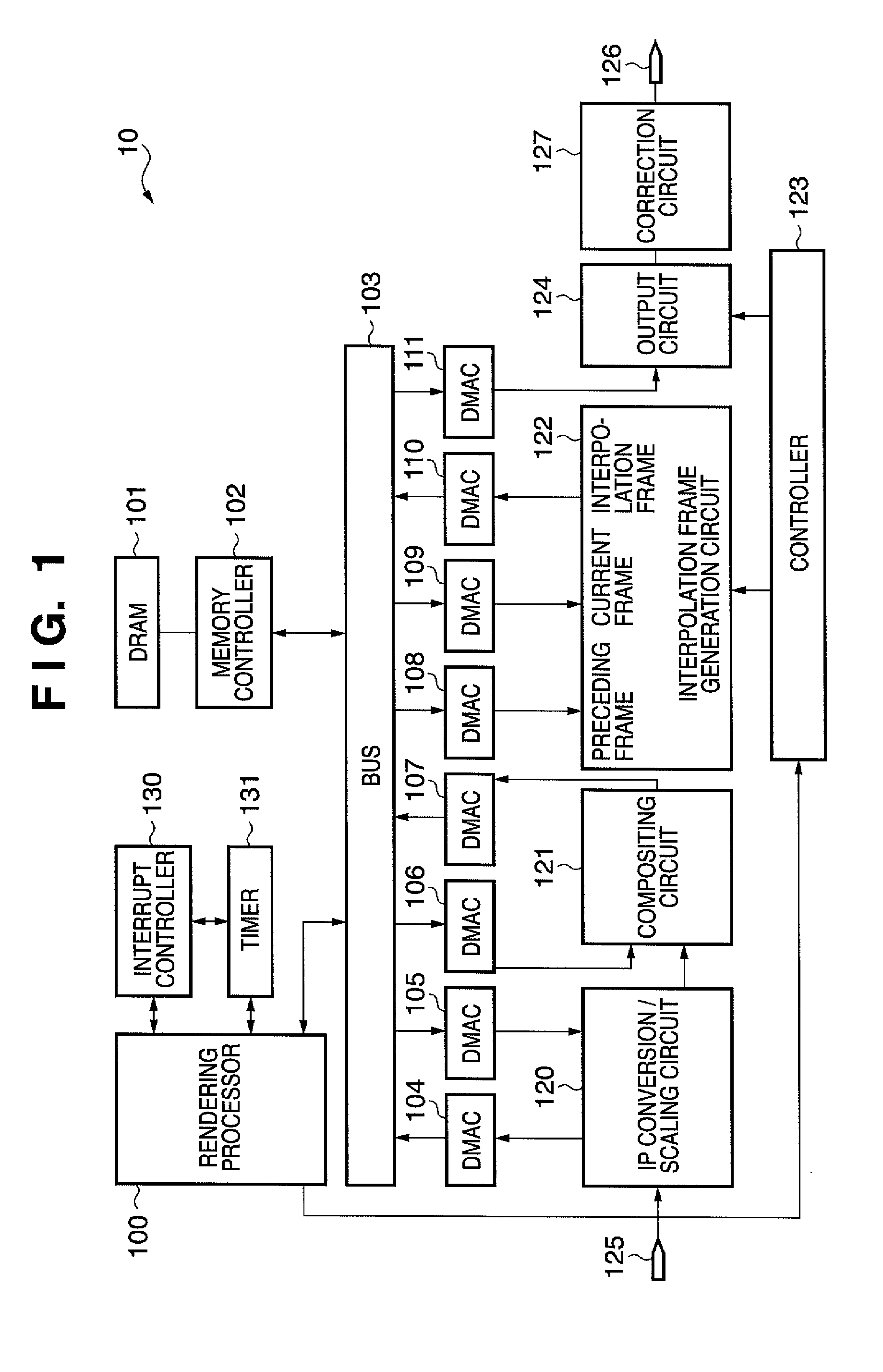Image processing apparatus and image processing method
a technology of image processing and image processing equipment, which is applied in the direction of color signal processing circuits, instruments, television systems, etc., can solve the problems of data transmission bandwidth bottlenecks, difficult to expand data transmission bandwidth as much, and increase costs, so as to achieve the effect of suppressing the occurren
- Summary
- Abstract
- Description
- Claims
- Application Information
AI Technical Summary
Benefits of technology
Problems solved by technology
Method used
Image
Examples
first embodiment
10>
[0058]FIG. 1 is a diagram illustrating the configuration of an image processing apparatus 10 according to a first embodiment utilizing the technology of the present invention.
[0059]The image processing apparatus 10 includes a rendering processor 100, which is an example of a generating unit, and an interpolation frame generation circuit 122, which is an example of an interpolating unit. The rendering processor 100 renders (generates) the image data that is composited with (each piece of frame data of) the video data. The interpolation frame generation circuit 122 generates interpolation frame data that is inserted between the frame data. The interpolation frame data is used for changing (especially, accelerating) the frame rate. Any suitable technology, such as, for instance, the one described in Japanese Patent Laid-Open No. 10-191268, can be used to generate interpolation frame data.
[0060]The reference numeral 101 designates a DRAM, which is a memory used as a frame memory for ...
second embodiment
[0119]The image processing apparatus 10 according to the first embodiment completely stopped the generation of interpolation frame data when predetermined conditions were met.
[0120]Incidentally, menu screens and other composite images are often represented by still images or by animation images having a low frame rate. In such cases, generating interpolation frame data corresponding to the composite image areas in the original frames does not particularly improve the image quality of the composite images. This is due to the fact that, in many cases, the composite images do not change between the two original frames, on which the generation of interpolation frame data is based.
[0121]Accordingly, in the second embodiment, when the rendering processor 100 generates image data, the generation of interpolation frame data is halted only in those areas of the original frames where image data is composited. In areas other than those areas, the generation of interpolation frame data continue...
third embodiment
[0154]In a third embodiment, each portion of image data has a blending coefficient “α”. The blending coefficient “α” is a parameter that indicates the degree of transparency obtained when compositing image data with video images, in such a manner that the smaller the “α” is, the higher the degree of transparency of the image data becomes. In the present embodiment, interpolation frame data used for the compositing area is generated when the “α” is not more than a threshold value, i.e. when the image data is composited such that the degree of transparency is equal to, or greater than, a predetermined degree. Conversely, no interpolation frame data is generated when the “α” is more than the threshold value, with the frame rate of the compositing area accelerated based on the frame doubling scheme. Alternatively, priority is given to image data with a larger “α” (a low degree of transparency) and the frame doubling scheme is used as the frame rate conversion scheme in the compositing a...
PUM
 Login to View More
Login to View More Abstract
Description
Claims
Application Information
 Login to View More
Login to View More - R&D
- Intellectual Property
- Life Sciences
- Materials
- Tech Scout
- Unparalleled Data Quality
- Higher Quality Content
- 60% Fewer Hallucinations
Browse by: Latest US Patents, China's latest patents, Technical Efficacy Thesaurus, Application Domain, Technology Topic, Popular Technical Reports.
© 2025 PatSnap. All rights reserved.Legal|Privacy policy|Modern Slavery Act Transparency Statement|Sitemap|About US| Contact US: help@patsnap.com



